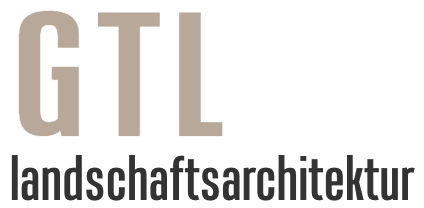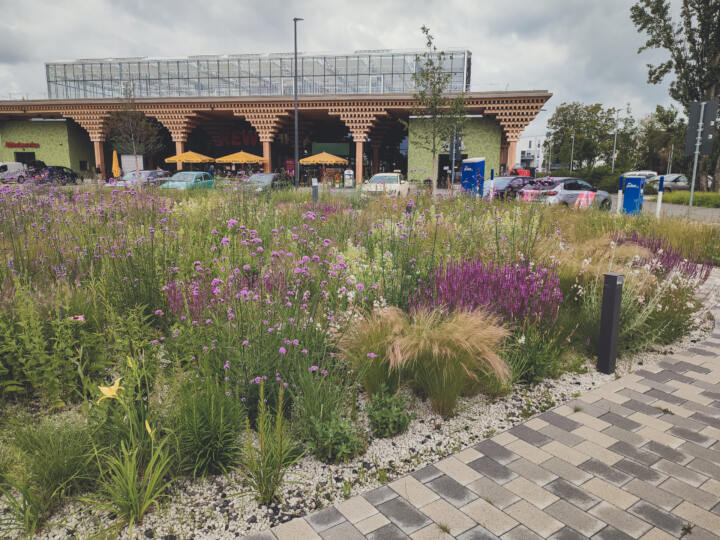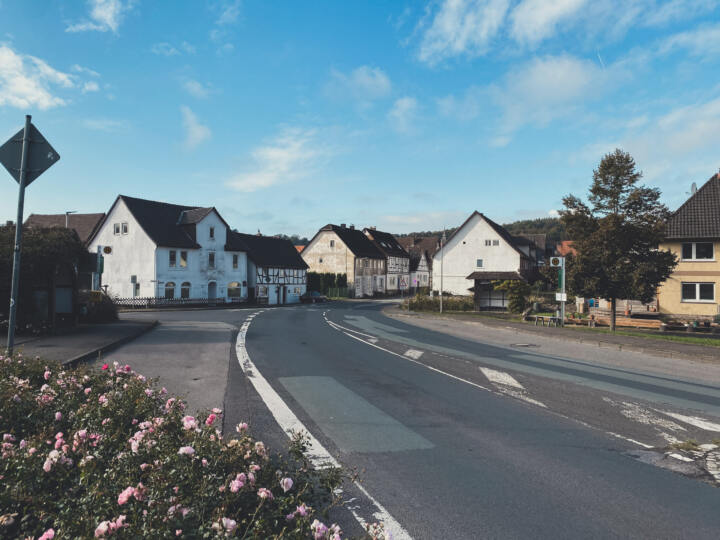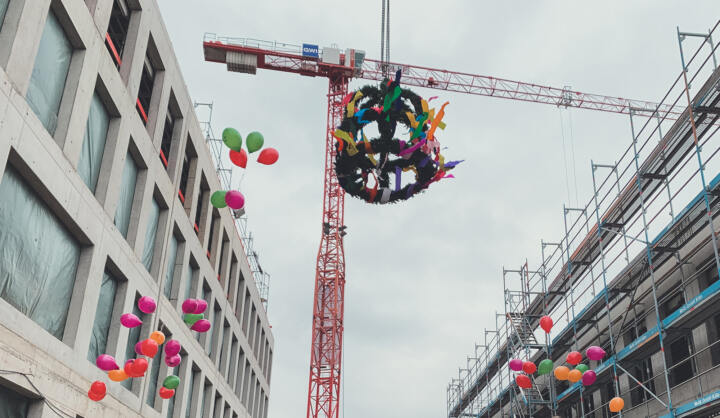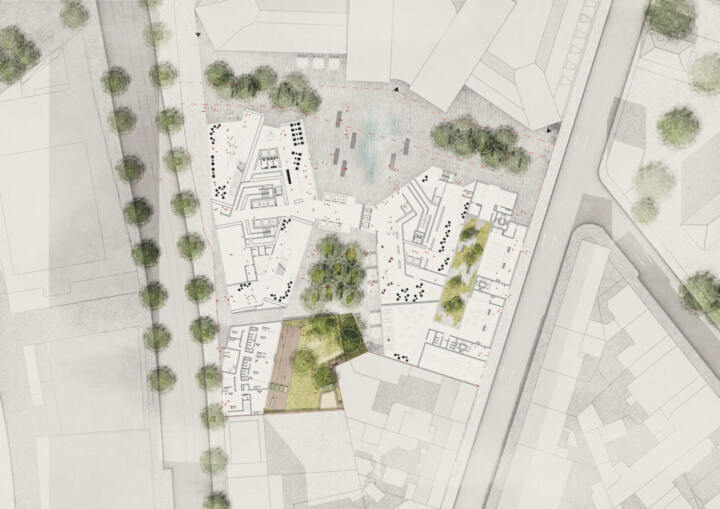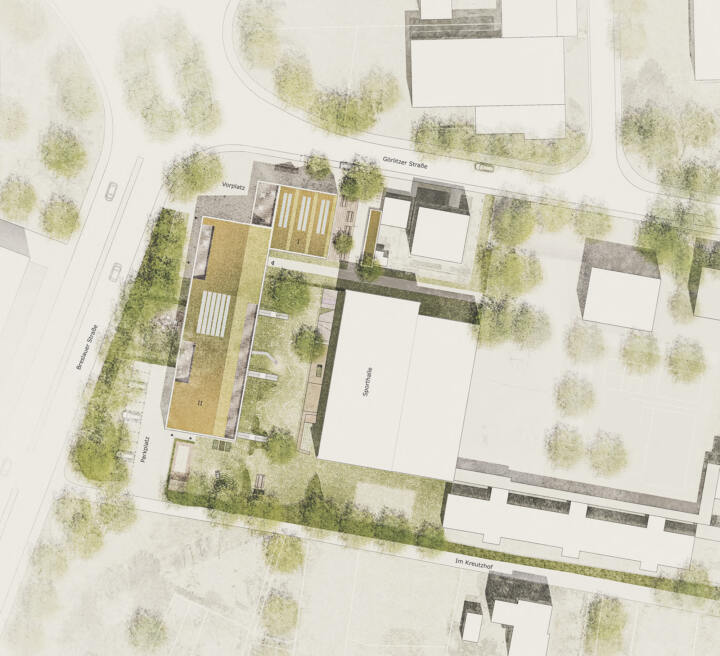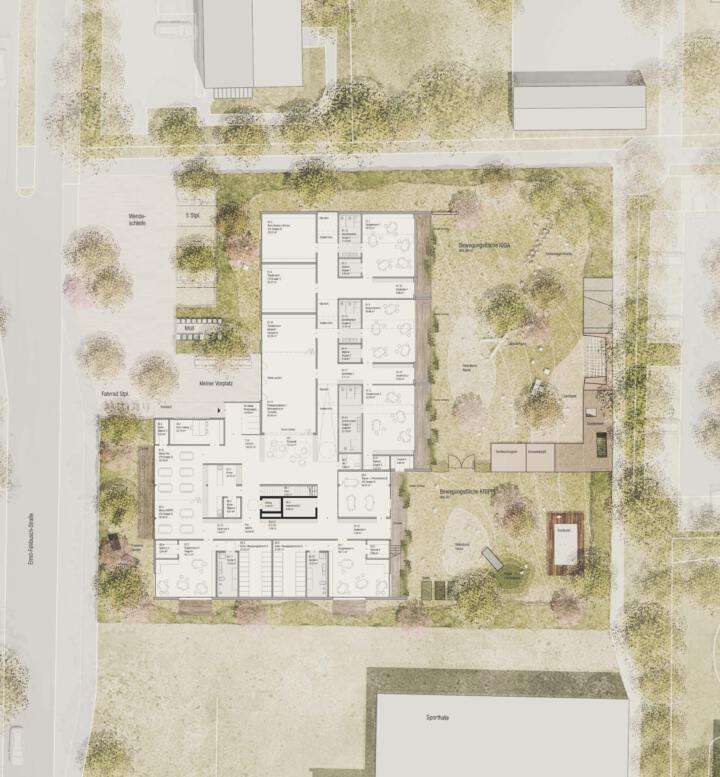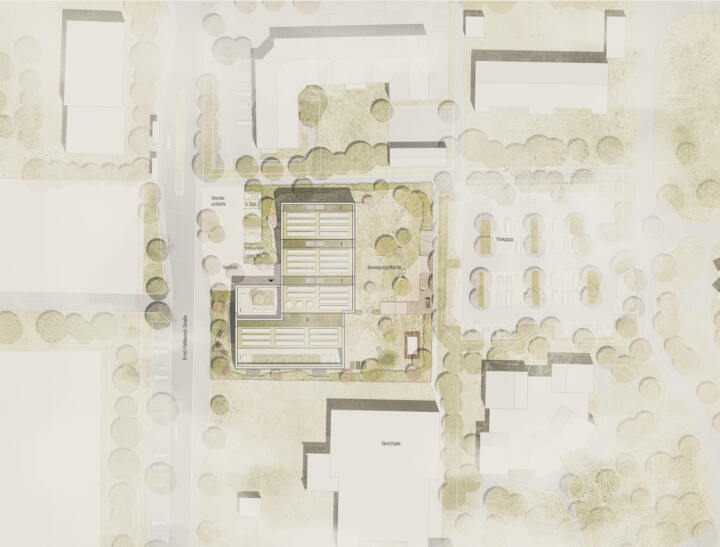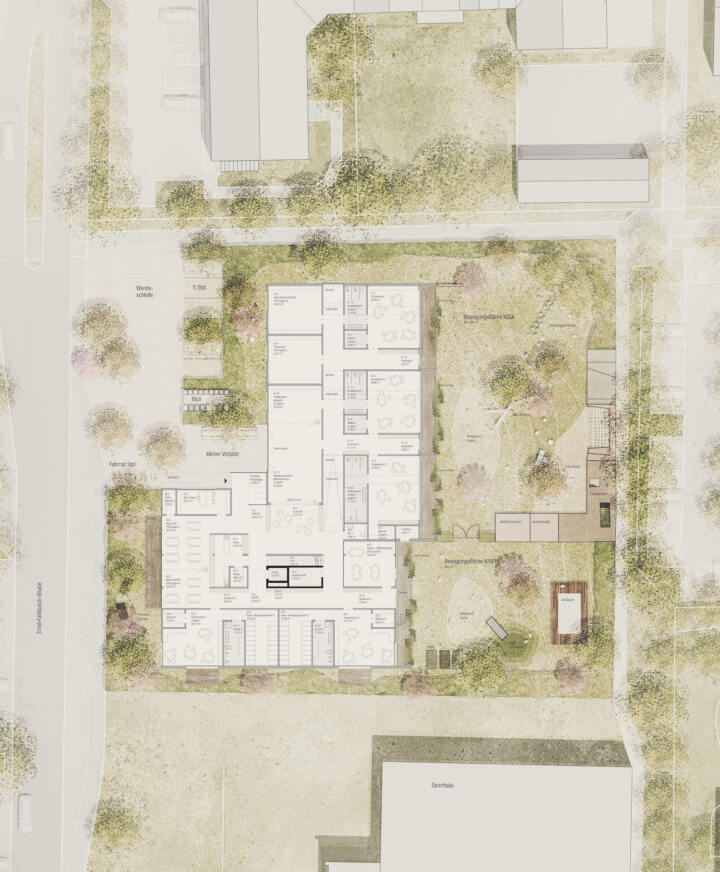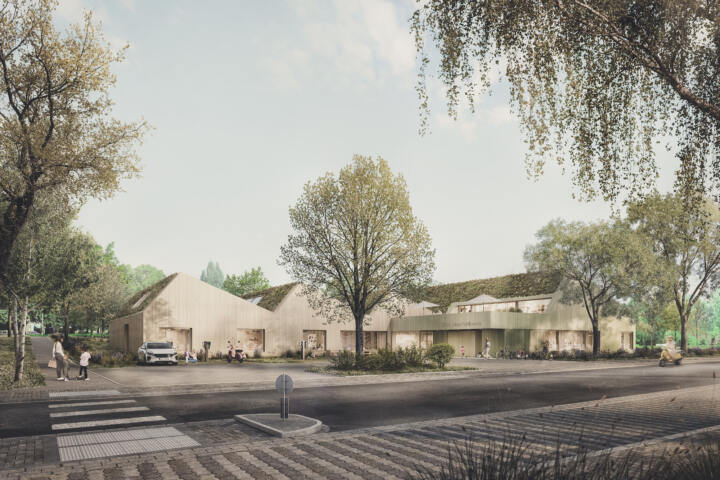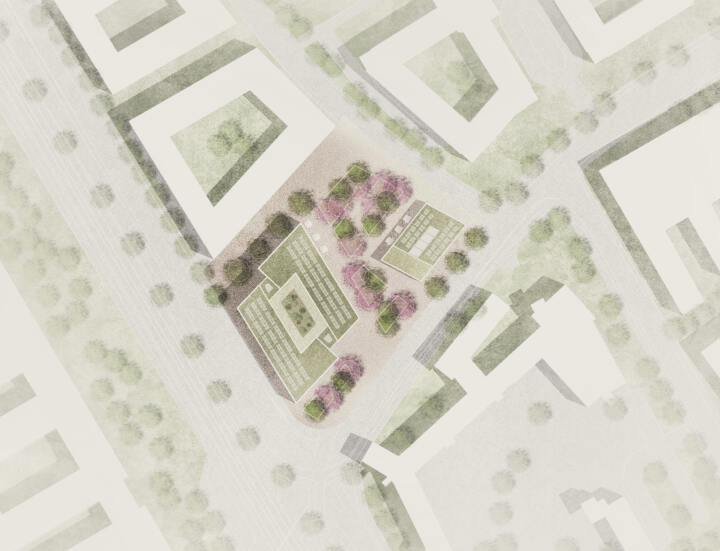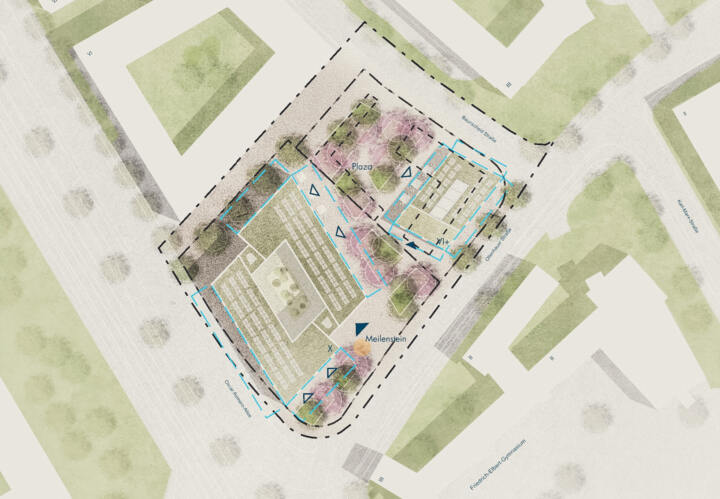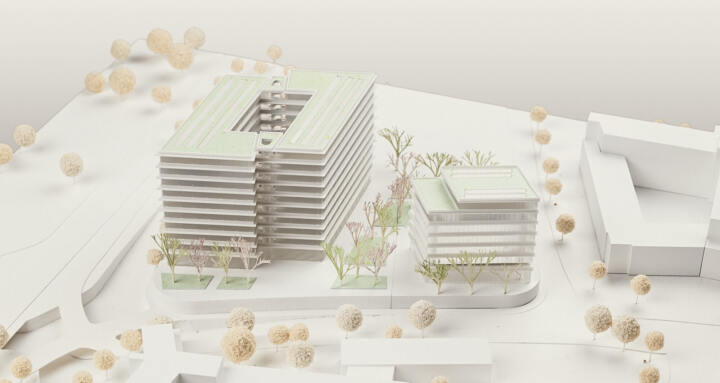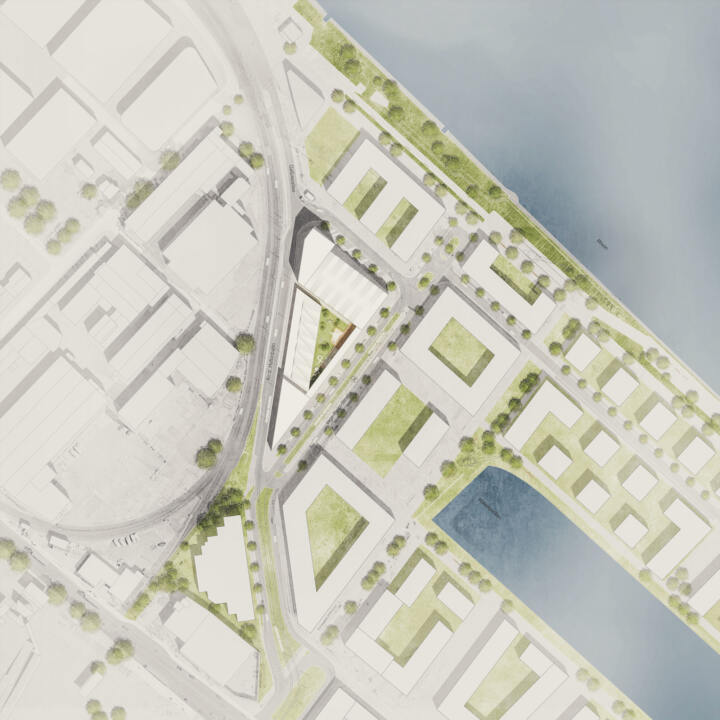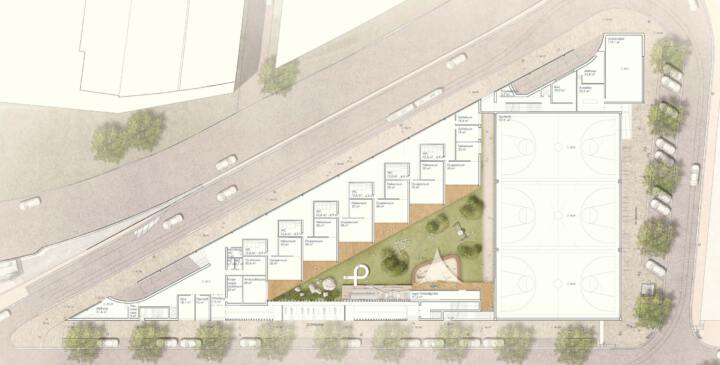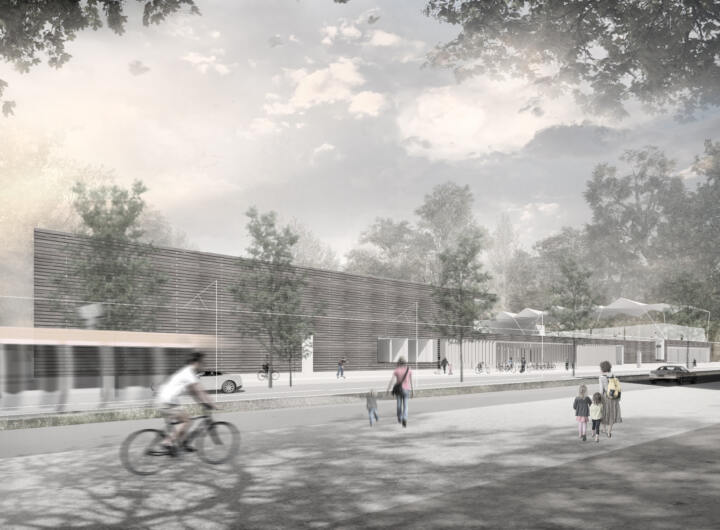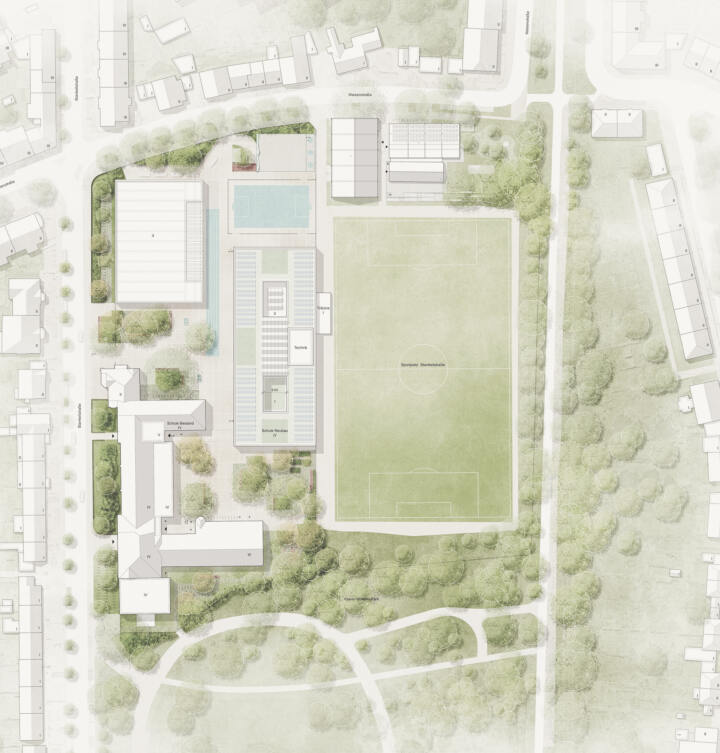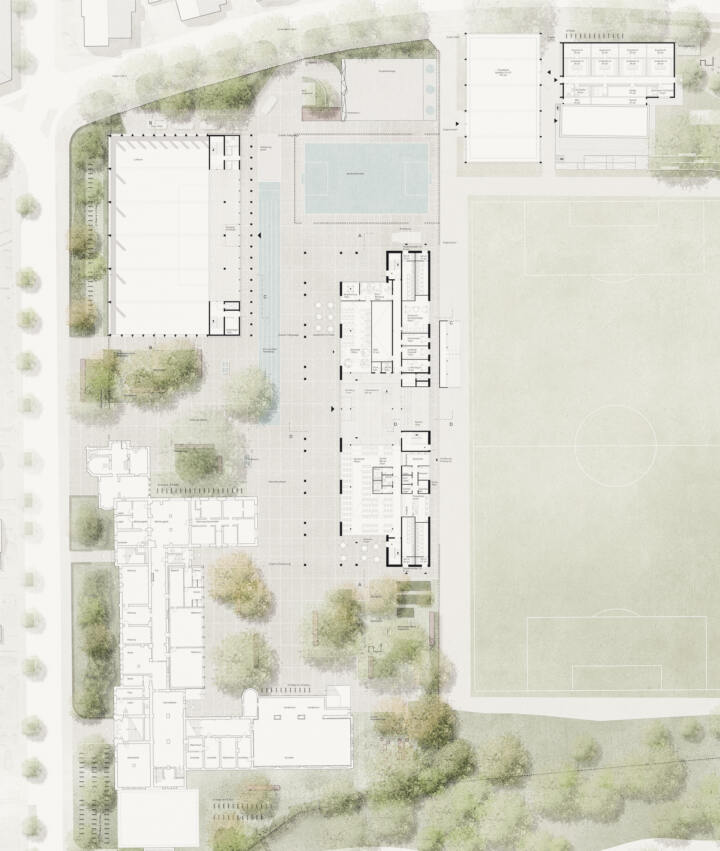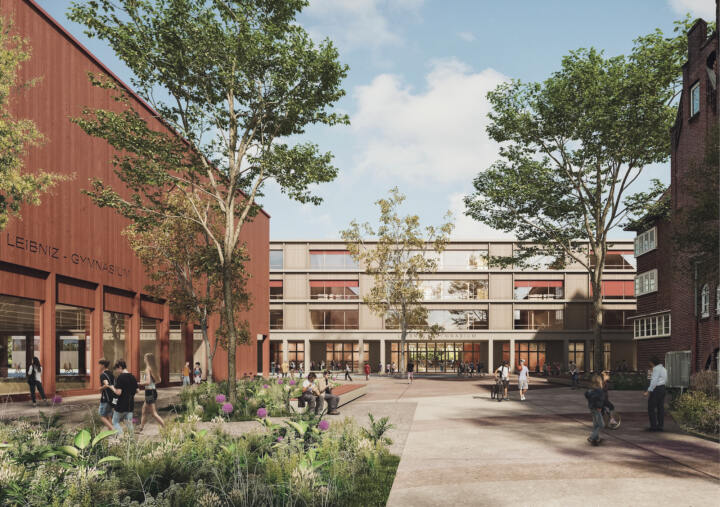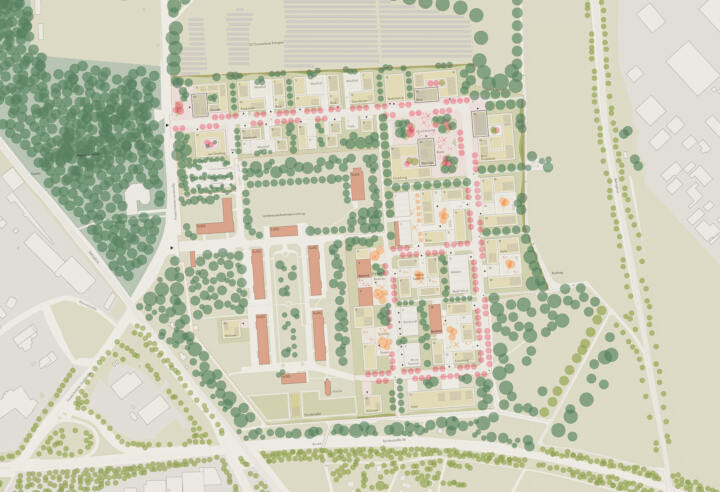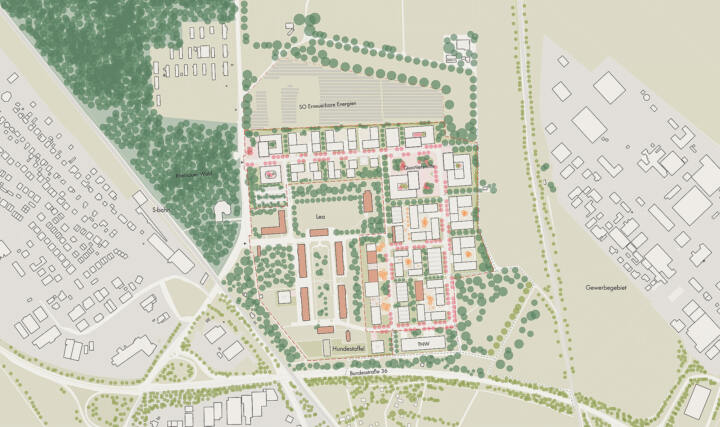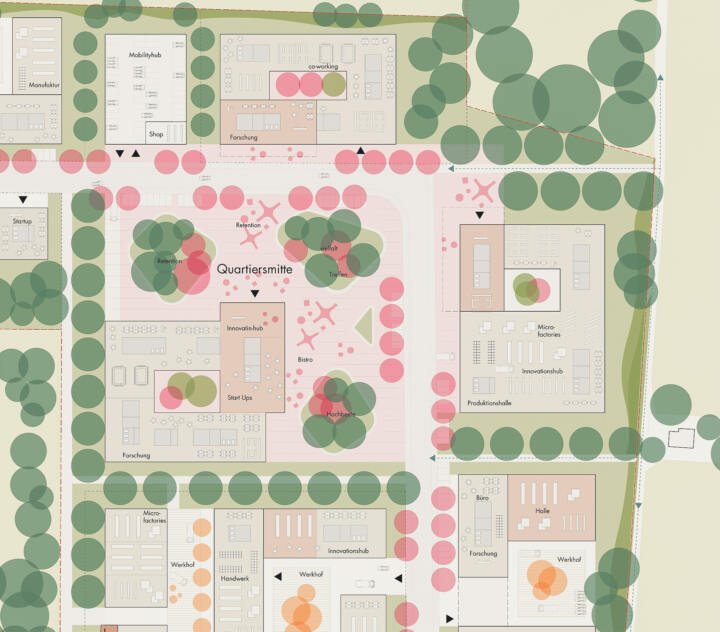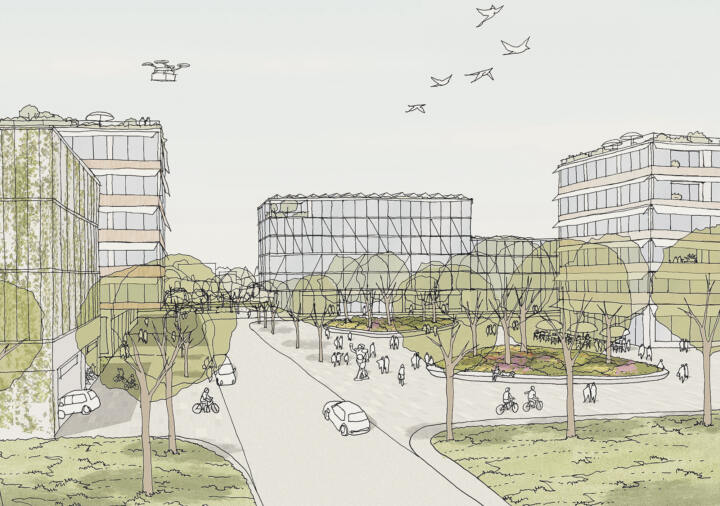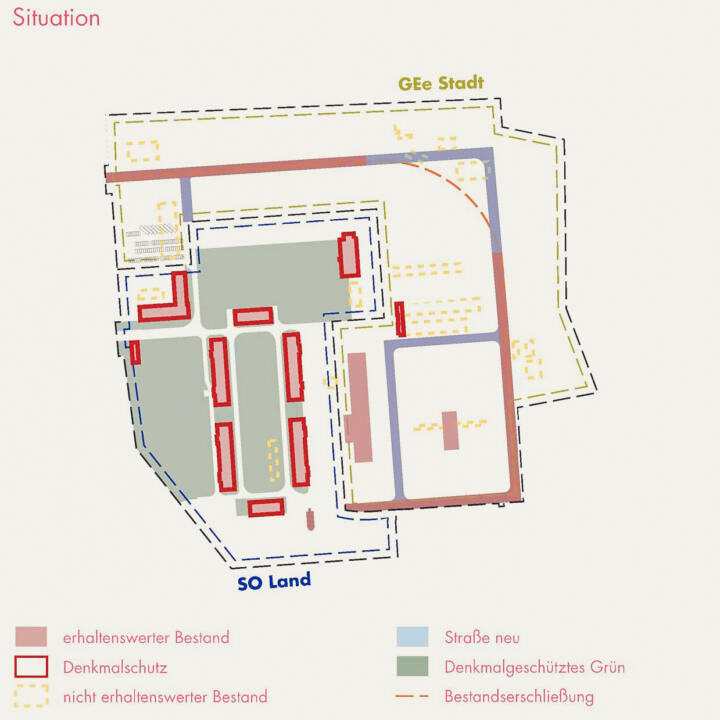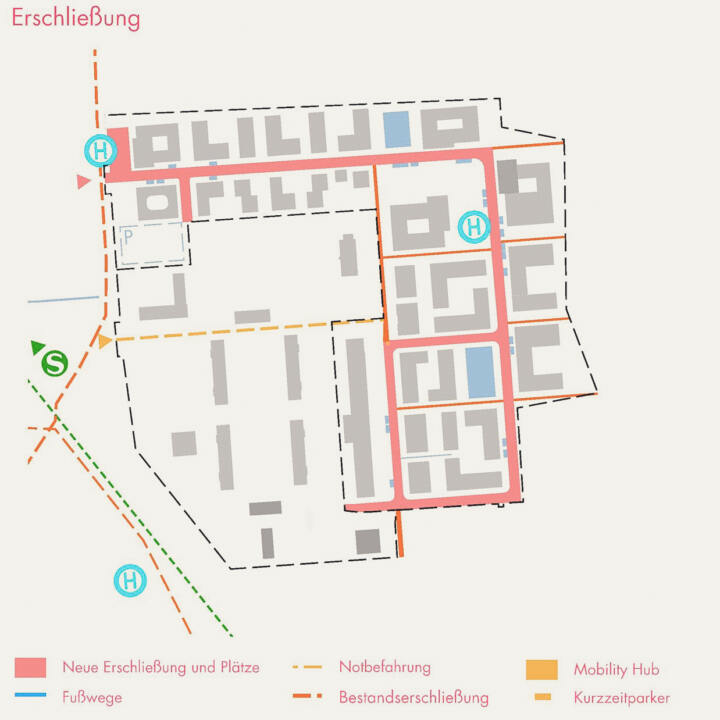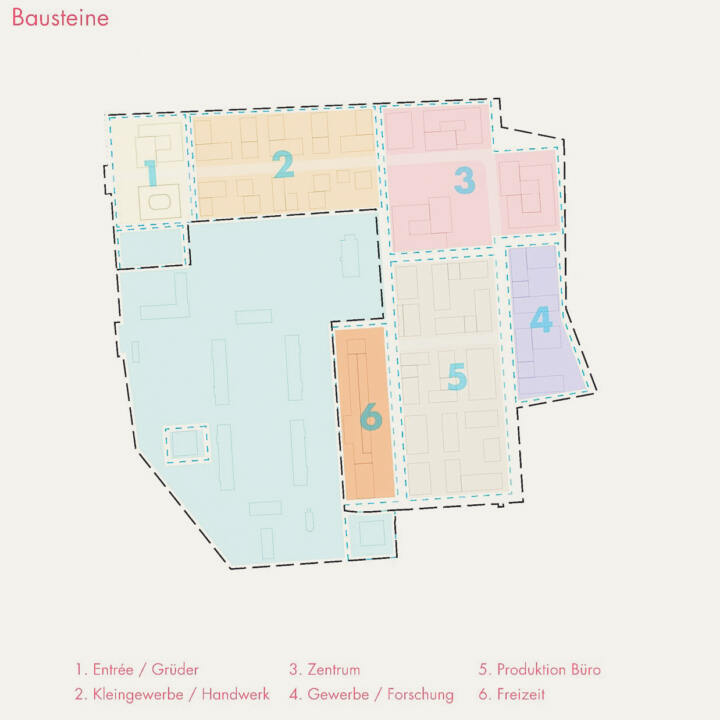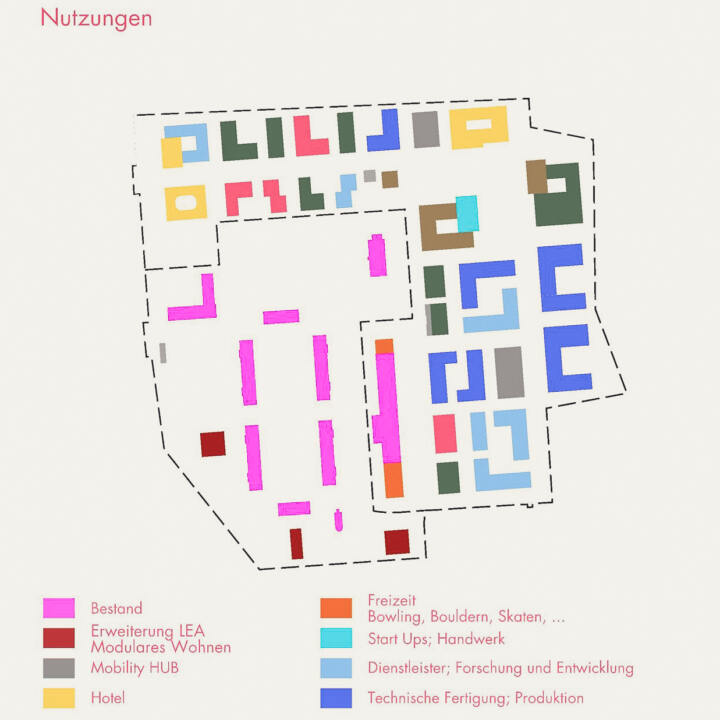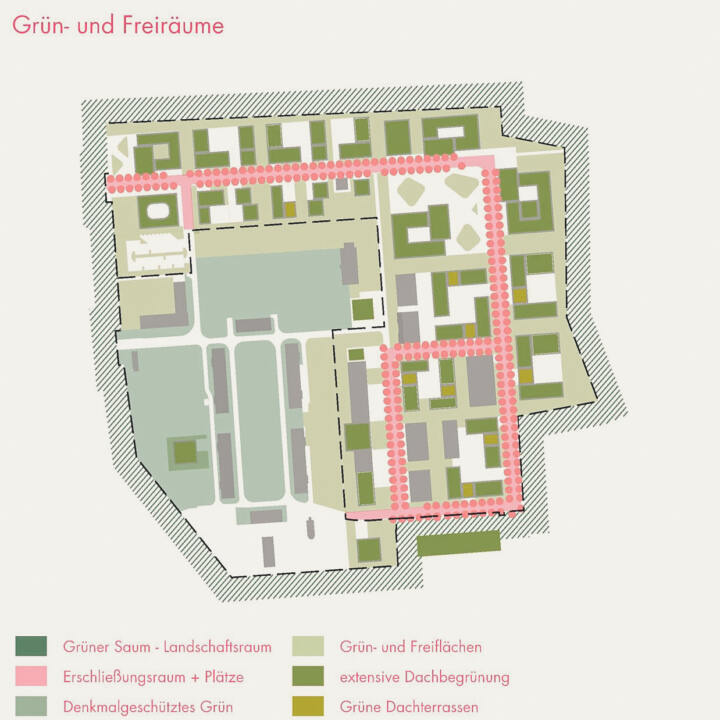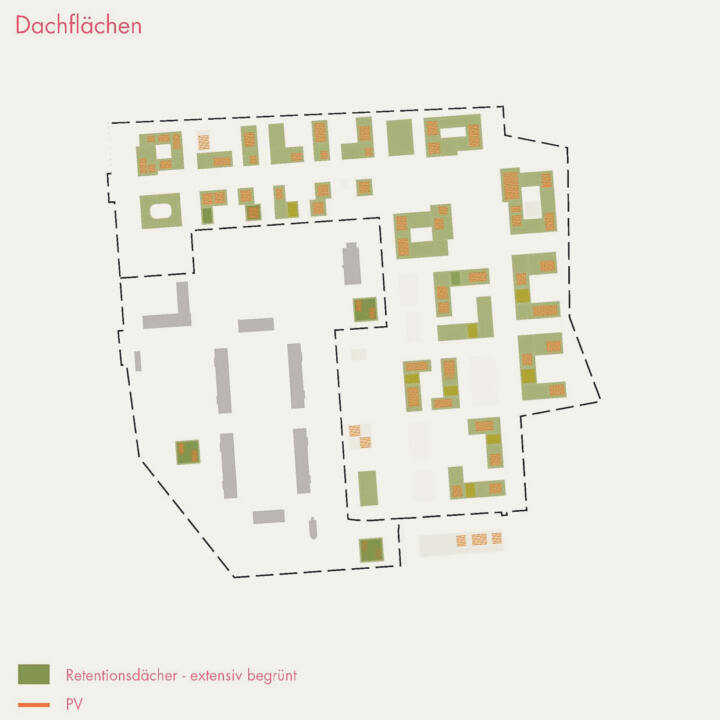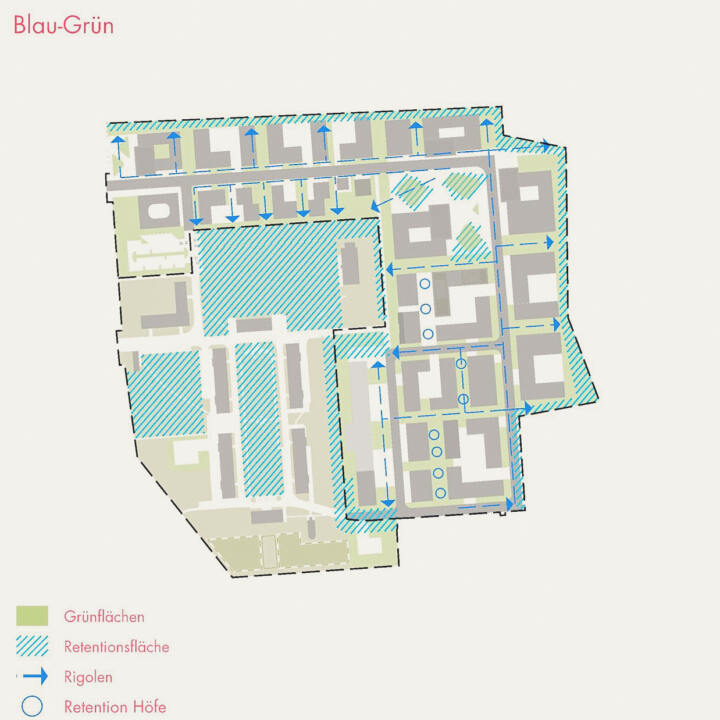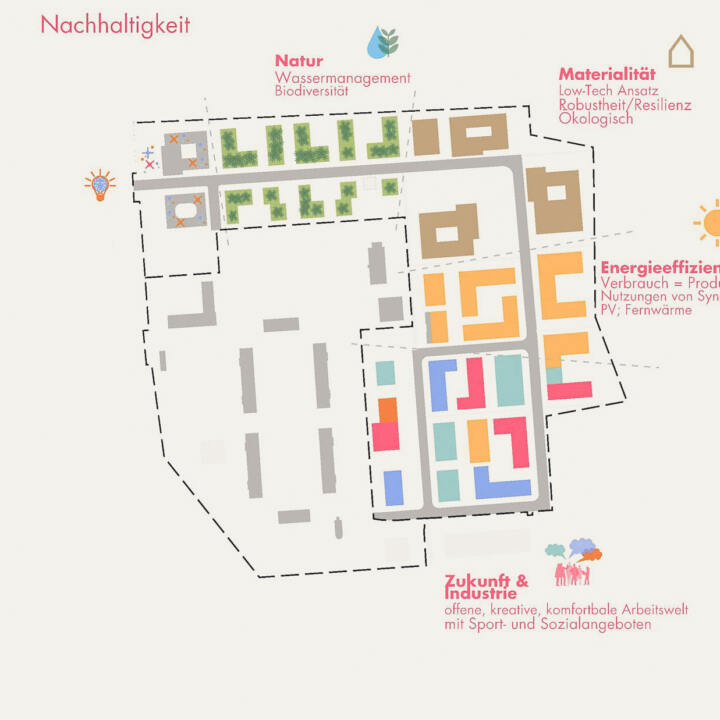10 | 2022 PROJECT
REWE Green Market Wiesbaden
Update
One year after the opening of Rewe's new pilot store in Wiesbaden-Erbenheim the mixed perennial planting shines. When selecting the plants, attention was paid to drought tolerance, extensive care and a long flowering period. In addition to the striking architecture, the perennial planting is a special eye-catcher. ©GTL
10 | 2022 PROJECT
Poststraße Helmarshausen
Surcharge
We are pleased about the assignment together with the Oppermann engineering office to redesign the through road in Helmarshausen. After we prepared the feasibility study in 2021, we were now able to use the VgV procedure prevail against the competition and look forward to the implementation. ©GTL
01 | 2022 PROJECT
Monheimer Tor, Monheim
Topping-out ceremony
The existing shopping center in Monheim, the Monheimer Tor, is supplemented and enlarged by an extensive new building. GTL is responsible for the planning of the roof and interior greening. On 21.01.2022 the new building was inaugurated by a public topping-out ceremony.
During a speech, among others by the building owner, the topping-out tree was raised and the building was then consecrated with the traditional topping-out ceremony by the carpenter. This celebration marks a successfully completed milestone on the road to completion in 2024. ©GTL
12 | 2021 COMPETITION
Millennium Areal Frankfurt
Recognition
In the international realization competition, together with the architects schneider+ schumacher, we received recognition for our contribution. The development of the Millennium Areal in Frankfurt and the extension by two high-rise buildings with mixed use shall shape the skyline in a sustainable, resource-saving and climate-friendly way.
The building ensemble complementing Tower185 integrates offices, a hotel, apartments, stores, gastronomy and a kindergarten. The outdoor space is divided into a forecourt with a fountain and groves of trees, inner courtyards and a kindergarten play area. ©GTL
11 | 2021 COMPETITION
Family Center, Learning Workshop and Daycare Center, Waldau Campus Kassel
1st Prize
The new family center at the Waldau Campus has an open and inviting structure with a spacious forecourt and entrance area. A wooden deck serves there as a meeting point and waiting area in front of the building. The garden consists of an undulating lawn and a linear play element with multiple uses, terraces for sitting for the learning workshop and for the children's restaurant. Planting beds and fruit trees are provided for the children to explore and snack on. ©GTL
Day Care Centre Ernst Fahlbusch | Göttingen
1. Prize | Day Care Centre Ernst Fahlbusch
Göttingen
In collaboration with pape+pape Architekten
With the new building of the day care centre, another educational and social facility is integrated into the existing urban situation of the city. A spacious forecourt including parking spaces forms the entrance area and offers enough space for daily exchange among parents or for events of the KITA. Various climbing and balancing facilities, a covered sand playground and other play and retreat facilities create a sensory stimulating play experience for all age groups. A separate movement area for the crèche contains further play and learning elements for toddlers. The outdoor space is complemented by beds for all children to sow and harvest their own crops. The generously planned terrace also offers the opportunity to taste delicious fruits and herbs from the snack garden.
Large contiguous green spaces, green roofs and terraces throughout, and a few paved areas create an overall concept that is close to nature and blends sensitively into the existing green space. Offsets in the cubature of the building figure and the resulting interior layout create clear allocations and zoning in the open space:
A spacious forecourt, which integrates the turning loop including parking spaces into the design, leaves plenty of space for daily exchange among parents and offers an ideal place for occasional KITA events. A linear play sculpture (which also integrates the wood workshop and the tool shed, among other things) offers a play experience that stimulates all the senses for all age groups, from various climbing and balancing opportunities, a covered sand playground to retreat and cuddle boxes. At the same time, the movement areas of the KIGA and KRIPPE are spatially separated as a matter of course. The outdoor area for the CRIPPER groups can be separated from the rest of the play area by low wooden gates if necessary and will have its own sandbox with deck and playhouse and a small grassy hill with a toddler slide. Enough space remains that further play facilities could be arranged. Beds for sowing and harvesting are provided for both age groups. The terrace at the dining area is embedded in a snack garden with a rich offer of delicious fruits and herbs and screened from the rest of the grounds by low fruit hedges. In the rest of the grounds, too, the shrub borders are enriched with strawberries, blueberries and mint; all shrubs and trees are fruiting and/or suppliers of craft materials such as nut and fruit trees or chestnuts. The green corridor running in a north-south direction with trees worth preserving is completely preserved.
Milestone Federal district | Bonn
Recognition | Milestone Federal district
Bonn
In collaboration with Schneider + schumacher
The high-rise integrates into the block-like structure and serves as a residential and office building with a variety of ground floor uses. The open spaces consist of a lit inner courtyard in the foyer and a publicly accessible green plaza.
The urban development concept envisages two compact solitaires on the two plots – together with the adjacent buildings they form an ensemble with a spatially clearly defined “green plaza”. The ground floor is intended for public use. A foyer at the corner of Ollenhauerstrasse and the future plaza marks an open entrance. A green inner courtyard in the foyer on the ground floor is thus invitingly perceptible into the urban space. Smaller commercial uses, restaurants, cafés, bakeries and fitness studios are proposed uses on the ground floor, which could also be laundromats or to-go markets depending on the tenancy. The flats will have balconies and can be designed as 2- to 4-room flats (at the corners of the building). Due to the noise emission on Oscar-Romero-Allee, the residential use should be realised in the part of the building facing the plaza. Thus, half of the high-rise building would be office and the other half residential. This makes sense because of the address formation, development, facade structure and the shaft layout.
The urban setting creates a strongly greened outdoor space that offers an attractive place to spend time outdoors, even if the first building block is realised exclusively. The continuous carpet of large-format, finely nuanced gray-beige slabs is structured by planting areas in such a way that the access area and areas for outdoor catering are kept generously open. At the same time, quiet and sheltered lounging areas are created without the need for consumption, taking into account all walkways and potential pedestrian shortcuts. The lush, low-maintenance grass/shrub plantings display a continuous, changing flush of flowers throughout the year. They are somewhat lowered to provide retention space in the event of flooding and also absorb normal precipitation so that rainwater only has to be discharged into the sewage system in exceptional cases via the raised inlets. All access roads, delivery and fire brigade parking areas can easily be integrated into the open space concept. For a short break in between or a longer stay outside, benches with and without backrests are arranged along the planting beds, partly across the corner. Loosely arranged sophores show their creamy white blossoms in June, when no other trees are in flower, and amber trees with their scarlet autumn foliage are placed in such a way that both shady and sunlit areas are created.
Gassnerallee Customs Port | Mainz
1. Prize | Gassnerallee customs port
Mainz
In collaboration with schneider + schumacher
The new building ensemble consisting of a day-care centre and a three-field sports hall plays a special role in the Zollhafen district, which is otherwise dominated by residential and commercial areas. The new building parts occupy the site mainly as single-storey buildings. The day care centre has a multipurpose room on the upper floor with a terrace in front. As a contrast to an urban environment in which children grow up in multi-storey residential buildings, all groups receive their own small ‘house’ with a direct ground-floor connection to the outdoor space, which, in addition to play areas for all, also offers smaller, sheltered and covered spaces. The three-court sports hall is buried by one storey to attractively interweave the activities inside with the surrounding urban space via the glass façade. The optional padel court is located at the northern tip of the site. Farm bike parking is located along the building to the east and south.
Leibniz-Secondary School | Essen
Recognition | Leibniz-Secondary School
Essen
The overall open space planning concept aims to create differentiated schoolyard areas with different characters, atmospheres and functions in order to provide pupils of all ages with a diverse and appealing range of uses.
The urban positioning of the new buildings creates a flowing open space structure, three open spaces with different characters and identities along a connecting promenade. In the southern area of the existing building, a green, rather introverted open space is created with a learning and play landscape that integrates the existing trees and supplements them with new plantings, thus translating the theme of the Kaiser Wilhelm Park to the south into the schoolyard. In the central area of the site, between the new and old school buildings, the sports hall and Stankeitstrasse, an open, multifunctional square area is being created, which also forms the main access to the school for bicycle and pedestrian traffic in an appropriate gesture. In the northern area between the sports hall and the clubhouse, the focus is on functional sports fields. In addition, the Kiss & Ride zone and underground car park access are located in this area, coming from Waisenstraße, which ensures conflict-free access to the site.
Ein Pflasterteppich aus Betonstein mit wasserdurchlässigen Fugen bildet die Grundlage im Kontext der Materialität des Schulhofes. Flächen aus Wassergebundener Wegedecke in Kombination mit üppigen Pflanzflächen und Baumpflanzungen bilden Bereiche mit Aufenthaltsqualität und besonderem Mikroklima. Zudem besitzen sie die Funktion als Entwässerungsflächen, die anfallendes Regenwasser aufnehmen, speichern und versickern können.
Der Freiraum rund um das Vereinsheim erhält einen grünen Charakter. Im östlichen Bereich wird der Baumbestand erhalten und es werden Spiel- und Aktivitätsangebote geschaffen. Rasenstufen im Böschungsbereich bilden Aufenthaltsqualität im Kontext des Sportplatzes aus und fangen den Höhenunterschied ab.
Innovative industrial estate | Schwetzingen
Multiple commission 1st prize | Innovative industrial estate
Schwetzingen
In collaboration with Schneider+Schumacher
Natural integration and gradual development
The special island location of the area, embedded in neighbouring landscapes with forests and valuable biotopes, requires a careful and flexible development strategy. This must react responsibly to the different ecological and social requirements. The aim is to protect the natural environment and at the same time offer the opportunity to adapt to the dynamic requirements of the surroundings.
A key objective of the planning is to clearly define the edges of the area in order to create a clear settlement boundary to the neighbouring landscape. This is essential in order to preserve and protect important green spaces and ecological connections in the long term.
The commercial area
The commercial area is understood as a programmatic unit that integrates a variety of plot sizes and utilisation profiles. This enables the establishment of high-quality industry, service companies, research facilities and science. The flexible utilisation is intended to create an attractive location that meets different economic requirements.
In the area known as the LEA, the listed buildings will be retained. This will be supplemented by two separate residential buildings that will be carefully integrated into the existing ensemble. This approach preserves the historical character and at the same time allows for a gentle further development of the area.
Thematic areas and different utilisation structures will be created within the commercial area. This allows for flexible marketing that is geared towards the specific needs of potential tenants and users. Both small-scale and large-scale developments can be realised.
Plot sizes and development dynamics
The development of the business park allows for flexible development with variable plot sizes, ranging from small (S) to medium (M) to large (L) and very large (XL). This offers space for different types of business, from low to high buildings, and enables dynamic adaptation to demand.
Development and networking
The new main development of the area will be largely retained. By maintaining the existing infrastructure, better property layouts are made possible. A central, green main square serves as a multifunctional meeting point and centrepiece of the area. This square forms the entrance and gives the area an inviting atmosphere.
Two mobility hubs not only serve as collection points for parking and sharing services, but also as places for communal and catering facilities. On the ground floor of these hubs, for example, bakeries, kiosks and small shops are planned to serve the area’s residents and workers.
The industrial estate’s road network will be closely linked to the surrounding roads. These include access to the S-Bahn station, cycle paths and a bridge over the neighbouring main road. This will ensure optimum accessibility for various road users.
Blue-green infrastructure and sustainability
All squares and streets in the industrial estate follow the principle of the sponge city. Care is taken to maintain the highest possible proportion of unsealed surfaces. Where possible, sealed surfaces will be equipped with infiltration-capable surfaces. Rainwater is channelled into open gutters and troughs where it can seep away and evaporate. Excess water is channelled into large retention areas to ensure efficient infiltration in the area.
All roofs in the area will be designed as green and retention roofs and equipped with photovoltaic systems. This will help to retain rainwater for as long as possible and generate sustainable energy at the same time.
The entire neighbourhood is characterised by changeable, flexible and yet durable structures. High-quality building materials are used that are recyclable and CO2-neutral. The aim is to achieve DGNB certification, which emphasises the sustainability and environmental friendliness of the project.
Gradual development and initial projects
The industrial estate will be developed successively from north-west to south-east. However, actual demand will also play a decisive role in the development process. The start-up centre at the Entrée, the innovation centre at Quartiersplatz and the existing leisure centre will serve as the initial spark, giving the starting signal for further development.

